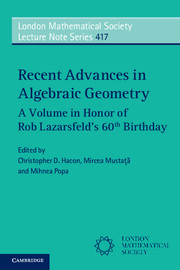In the spring of 2009, the entire MSRI semester was devoted to Algebraic Geometry. The first main workshop, held during the week of January 26-30 and entitled “Classical Algebraic Geometry Today”, served as an introduction to the whole program. It was designed to give a panorama of current progress in the field, of interest to experts, but presented in an introductory manner in order to make it accessible to those with only a general background. As a result, all talks contained a substantial expository and didactic component for the younger audience for whom the workshop was primarily intended.
One of the goals of the workshop was to reflect the diversity of Algebraic Geometry and its most fascinating recent developments. As such, it covered a wide range of topics such as birational geometry and classification, rational curves on algebraic varieties, moduli spaces of abelian varieties, derived categories and Fourier-Mukai transforms, curve counting invariants, holomorphic symplectic manifolds, and Hodge theory. Topics like modern enumerative geometry, moduli of varieties of general type, and combinatorial geometry, although represented at this event as well, were more strongly emphasized at other workshops organized throughout the semester.
The speakers at the workshop were, in alphabetical order: Mark de Cataldo, Olivier Debarre, David Eisenbud, Sam Grushevsky, Christopher Hacon, Joe Harris, Daniel Huybrechts, Jun-Muk Hwang, János Kollár, Robert Lazarsfeld, Alina Marian, Kieran O'Grady, Martin Olsson, Rita Pardini, Giuseppe Pareschi, Richard Thomas, Burt Totaro, and Yuri Tschinkel.
We hope that this volume closely reflects the spirit of the workshop. Intended to give an overview of the state of the art in the field, it is addressed to both beginners and specialists. As one of the fields in mathematics with the longest history, Algebraic Geometry has had an incredible evolution over the past century, with new subfields constantly branching off, with spectacular progress in certain directions, but at the same time, with many fundamental unsolved problems still to be tackled. The focus of the volume is on approaches to long-standing open problems (in other words, problems with a “classical” flavor) by means of modern techniques currently under development. Many of the surveys contain questions and conjectures which will hopefully lead to a flurry of activity and wonderful new results in the future.

 $\mathbb{Q}$-DIVISORS,
$\mathbb{Q}$-DIVISORS,  $V$-FILTRATION, AND MINIMAL EXPONENT
$V$-FILTRATION, AND MINIMAL EXPONENT
